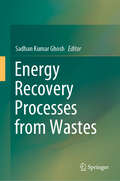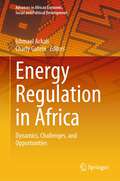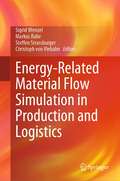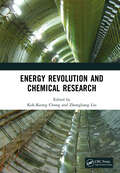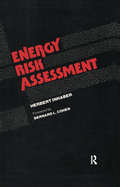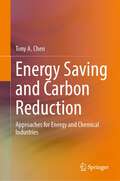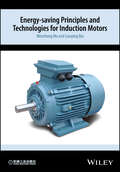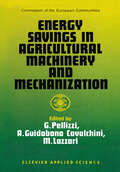- Table View
- List View
Energy Price Shocks and Macroeconomic Performance (Routledge Revivals)
by Douglas R. BohiThe oil price shocks of the 1970’s led to severe recessions in the 1980’s in the United States. Originally published in 1989 in the aftermath, Bohi attempts to show both how energy prices can cause a decline in output and employment and to explore important other factors which led to the recessions using the US, United Kingdom, Japan and Germany as examples. The findings in Energy Price Shocks and Macroeconomic Performance have major implications for energy policy and questions government plans which focus solely on preventing another oil supply disruption. This title will be of interest to students of environmental studies and economics as well as professionals.
Energy Production in the Mississippi River Delta: Impacts on Coastal Ecosystems and Pathways to Restoration (Lecture Notes in Energy #43)
by J. W. Day R. G. Hunter H. C. ClarkFor nearly a century, the energy industry had a profound impact on the Mississippi Delta, including both the natural and socio-economic systems. The purpose of this book is to describe the delta, how oil and gas (O&G) activities have impacted both natural and socio-economic systems and how much of the degradation could have been avoided. The Mississippi Delta formed over the past six thousand years but, in less than a century, lost 25 percent of coastal wetlands. O&G activities contributed significantly to this loss. O&G production began in the early 20th century and over 600 conventional fields were developed. Production ramped up rapidly, peaking around 1970, then declined. As O&G production declines, produced water dominates fluid production, and this high salinity brine is laced with a variety of toxins. Often, O&G was produced rapidly and much was left in the ground and is now technically and economically unavailable. With careful planning, this situation could have been avoided. The industry also affected the regulatory framework by weakening regulations, enforcement and impacts were not adequately addressed, and more profits flowed out of state. Thus, the state was economically and environmentally worse off. The industry should be compelled to contribute expertise and financial resources to restoration of the delta.
Energy Production Systems Engineering (IEEE Press Series on Power Engineering)
by Thomas Howard BlairEnergy Production Systems Engineering presents IEEE, Electrical Apparatus Service Association (EASA), and International Electrotechnical Commission (IEC) standards of engineering systems and equipment in utility electric generation stations. Includes fundamental combustion reaction equations Provides methods for measuring radioactivity and exposure limits Includes IEEE, American Petroleum Institute (API), and National Electrical Manufacturers Association (NEMA) standards for motor applications Introduces the IEEE C37 series of standards, which describe the proper selections and applications of switchgear Describes how to use IEEE 80 to calculate the touch and step potential of a ground grid design This book enables engineers and students to acquire through study the pragmatic knowledge and skills in the field that could take years to acquire through experience alone.
Energy Production Systems Engineering (IEEE Press Series on Power Engineering)
by Thomas Howard BlairEnergy Production Systems Engineering presents IEEE, Electrical Apparatus Service Association (EASA), and International Electrotechnical Commission (IEC) standards of engineering systems and equipment in utility electric generation stations. Includes fundamental combustion reaction equations Provides methods for measuring radioactivity and exposure limits Includes IEEE, American Petroleum Institute (API), and National Electrical Manufacturers Association (NEMA) standards for motor applications Introduces the IEEE C37 series of standards, which describe the proper selections and applications of switchgear Describes how to use IEEE 80 to calculate the touch and step potential of a ground grid design This book enables engineers and students to acquire through study the pragmatic knowledge and skills in the field that could take years to acquire through experience alone.
Energy Project Financing: Resources and Strategies for Success
by Albert Thumann Eric WoodroofFirst published in 2008. This practical application reference provides a resource for those seeking to utilize the innovative methods now available to finance energy projects. The full scope of current project financing practices are fully examined and assessed, including coverage of energy service performance contracting, rate of return analysis, measurement and verification of energy savings, and more. Readers will receive the facts they need to assess a project's payback in advance, anticipate and avoid potential risks and/or hidden costs, and assure that your energy project is an overall economic success. Other topics covered include financing international projects and ESCO’s (Energy Service Company’s) financing.
Energy Recovery from Municipal Solid Waste by Thermal Conversion Technologies
by P. Jayarama ReddyThis book presents an overview of municipal solid waste recycling, and how it can be used to generate clean power, transport fuels that can substitute fossil fuels, and value-based chemicals with minimal environmental impact. It also explains how hazardous wastes and sewage sludge can be treated and disposed of without affecting human and environmental health. A full discussion of established thermal conversion technologies that generate heat, electricity, liquid fuels and useful chemicals from solid waste and supporting case studies describing global waste-to-energy plants in operation make this work highly suited to an introductory course on waste thermal conversion processes.
Energy Recovery from Municipal Solid Waste by Thermal Conversion Technologies
by P. Jayarama ReddyThis book presents an overview of municipal solid waste recycling, and how it can be used to generate clean power, transport fuels that can substitute fossil fuels, and value-based chemicals with minimal environmental impact. It also explains how hazardous wastes and sewage sludge can be treated and disposed of without affecting human and environmental health. A full discussion of established thermal conversion technologies that generate heat, electricity, liquid fuels and useful chemicals from solid waste and supporting case studies describing global waste-to-energy plants in operation make this work highly suited to an introductory course on waste thermal conversion processes.
Energy Recovery Processes from Wastes
by Sadhan Kumar GhoshThe book focuses on a global issue—municipal solid waste management (MSWM) and presents the most effective solutions based on energy recovery processes. There is huge potential in employing different technologies and modern management methodology for recovering energy from various waste streams to establish a sustainable and circular economy. In several countries, energy recovery from municipal solid wastes (MSW) is seen as a way of reducing the negative impact of waste on the environment and also reducing the burden on land resources. The book primarily focuses on highlighting the latest insights into energy recovery from various waste streams in different countries, with a particular emphasis on India. Further, it paves the way for sustainability in the energy sector as a whole by addressing waste management issues and simultaneous energy recovery. The chapters present high-quality research papers selected and presented in the conference, IconSWM 2018.
Energy Regulation in Africa: Dynamics, Challenges, and Opportunities (Advances in African Economic, Social and Political Development)
by Ishmael Ackah Charly GateteThis book analyzes the political economy governing energy regulation across the African continent. Presenting case studies that span diverse energy sectors and countries, it provides an overview of their complex political and regulatory frameworks. The book explores emerging technologies and energy markets, highlighting Africa’s preparedness for the energy transition, and sheds light on the pivotal role of cross-border energy trade with regard to energy access. Further, it examines regulators’ influence within regional power pools, as well as their contribution to gender mainstreaming in the energy sector, addressing vital social issues. This book is divided into five parts, the first of which focuses on the political economy of energy regulation. The second part discusses emerging technologies and climate change issues, while the third examines regional energy markets, and regional institutional collaboration. The fourth part features contributions on gender mainstreaming, while part five rounds up the coverage. The book will be of interest to policymakers and investors in Africa, as well as scholars interested in energy regulation and economics.
Energy-Related Material Flow Simulation in Production and Logistics
by Sigrid Wenzel Markus Rabe Steffen Strassburger Christoph Von ViebahnThis book provides for the first time an overview on the current approaches and applications of energy aspects in production and logistics by the use of simulation techniques. During the last decade, the importance of energy in the material flow processes has become more and more important. The pressure to reduce the environmental footprint of production and logistics systems will even intensify in future. Therefore, enterprises have started to integrate the use of energy into their planning processes much more than before, even designing feedback loops, e.g., from energy control to production control. This receives additional attention with the increasing use of renewable, but less reliable, energy sources. Care must be taken to establish processes that aim to use energy when it is available. As an example, many industrial processes like melting or coating have significant energy demands, but could vary the point of time of its consumption within specific limits, leading to a very high complexity. It discusses the construction and application of energy-specific performance indicators and analyzes the input information that needs to be acquired before implementing suitable models. On this basis, concrete technical solutions are introduced.
Energy Resources: Availability, Management, and Environmental Impacts
by Kenneth J. Skipka Louis TheodoreThe Energy ProblemEnergy Resources: Availability, Management, and Environmental Impacts identifies historical increases in demand and a continuing lack of viable management policies for regional and global energy problems. Considering the state and consumption of energy resources on a worldwide level, the authors outline and address three pr
Energy Resources in Bangladesh: Trends and Contemporary Issues
by Sakib Bin Amin Saanjaana RahmanThis book discusses the energy issues facing Bangladesh, specifically the lack of access to electricity that impedes overall development. In-depth chapters examine critical energy problems and provide possible solutions including energy conversion and energy efficiency and the utilization of energy reform strategies for further development of the energy sector. This book is useful to students and practitioners seeking a clearer understanding of contemporary energy issues, energy markets and their sustainable development, including modern technologies for energy conversion from as waste and strategies for efficiency. It presents thought-provoking ideas and strategies to help Bangladesh achieve Sustainable Development Goals (SDGs) and transition to an upper-middle income country by 2021, through the utilization of proper energy policies.
Energy Return on Investment: A Unifying Principle for Biology, Economics, and Sustainability (Lecture Notes in Energy #36)
by Charles A.S. HallThis authoritative but highly accessible book presents the reader with a powerful framework for understanding the critical role of the energy return on investment (EROI) in the survival and well-being of individuals, ecosystems, businesses, economies and nations. Growth and development are fundamental and ubiquitous processes at all scales, from individuals to food crops to national economies. While we are all familiar with the concepts of economic growth and living standards as measured by gross domestic product (GDP), we often take for granted the energy use that underpins GDP and our expectations for year-on-year growth. In this book, you will learn how these measures of “progress” are completely dependent on the balance that can be achieved between energy costs (inputs) and gains. Nothing is made or moved without an energy surplus, and it is the EROI of available energy sources more than any other single factor that determines the shape of civilization.Nearly all politics and economics assume that policy and market forces are the levers upon which future outcomes will hinge. However, this book presents many examples of historical and current events that can be explained much more clearly from an energetic perspective. In addition, a future scenario is developed that gives a central place to EROI in assessing the potential of governmental and private initiatives to substitute so-called renewable energy sources for diminishing stocks of fossil fuels. When cheap fossil fuels are no longer available in the abundance needed to mask economic problems and power business as usual, it will be EROI more than the plethora of “green” technologies that creates the boundary conditions for a sustainable future.
Energy Revolution: The Physics and the Promise of Efficient Technology
by Mara PrentissUsing full-color visualizations of key concepts and data, Mara Prentiss interprets government reports, technology, and basic physical laws to advance a bold claim: wind and solar power alone could generate 100% of the U.S. average energy demand, without lifestyle sacrifices. And meeting the actual U.S. energy demand with renewables is within reach.
Energy Revolution: The Physics and the Promise of Efficient Technology
by Mara PrentissUsing full-color visualizations of key concepts and data, Mara Prentiss interprets government reports, technology, and basic physical laws to advance a bold claim: wind and solar power alone could generate 100% of the U.S. average energy demand, without lifestyle sacrifices. And meeting the actual U.S. energy demand with renewables is within reach.
Energy Revolution and Chemical Research: Proceedings of the 8th International Conference on Energy Science and Chemical Engineering (ICESCE 2022), Zhangjiajie, China, 22–24 April 2022
by Kok-Keong Chong Zhongliang LiuThe primary goal of the book is to promote research and developmental activities in energy, power technology and chemical technology. Besides, it aims to promote scientific information interchange between scholars from top universities, business associations, research centers and high-tech enterprises working all around the world. The conference conducted in-depth exchanges and discussions on relevant topics such as energy engineering and chemical engineering, aiming to provide an academic and technical communication platform for scholars and engineers engaged in scientific research and engineering practice in the field of energy materials, energy equipment and electrochemistry. By sharing the research status of scientific research achievements and cutting-edge technologies, it helps scholars and engineers all over the world comprehend the academic development trends and broaden research ideas. So as to strengthen international academic research, academic topics exchange and discussion, and promote the industrialization cooperation of academic achievements.
Energy Revolution and Chemical Research: Proceedings of the 8th International Conference on Energy Science and Chemical Engineering (ICESCE 2022), Zhangjiajie, China, 22–24 April 2022
by Kok-Keong Chong Zhongliang LiuThe primary goal of the book is to promote research and developmental activities in energy, power technology and chemical technology. Besides, it aims to promote scientific information interchange between scholars from top universities, business associations, research centers and high-tech enterprises working all around the world. The conference conducted in-depth exchanges and discussions on relevant topics such as energy engineering and chemical engineering, aiming to provide an academic and technical communication platform for scholars and engineers engaged in scientific research and engineering practice in the field of energy materials, energy equipment and electrochemistry. By sharing the research status of scientific research achievements and cutting-edge technologies, it helps scholars and engineers all over the world comprehend the academic development trends and broaden research ideas. So as to strengthen international academic research, academic topics exchange and discussion, and promote the industrialization cooperation of academic achievements.
Energy Risk Assessment
by Herbert InhaberFirst Published in 1982. Comprehensive and controversial, this book presents an overview of the energy options available and their attendant risks. The entire energy cycle- from raw material to final energy production- is examined in depth so that accurate and detailed assessments can be made of the risks of energy options.
Energy Risk Assessment
by Herbert InhaberFirst Published in 1982. Comprehensive and controversial, this book presents an overview of the energy options available and their attendant risks. The entire energy cycle- from raw material to final energy production- is examined in depth so that accurate and detailed assessments can be made of the risks of energy options.
Energy Saving and Carbon Reduction: Approaches for Energy and Chemical Industries
by Tony A. ChenThe book provides an integrated energy/exergy analysis method to identify the energy utilization issues and systematically propose the cost-effective energy-saving and CO2 mitigation/capture solution. There is a strong market needs on energy-saving and greenhouse gas (GHG) reduction. CO2 mitigation/capture will achieve economic benefit of fuel, power, and carbon tax saving as well as environmental GHG reduction. The book is a professional book for energy-saving and GHG gas mitigation technology in oil & gas, oil refining, and chemical industry. It is an integrated technical book that combines energy utilization theory and practical method, including: thermodynamic analysis for unit operation and process units; energy and exergy calculation for various process streams and utilities; three-link energy/exergy analysis model; energy/exergy balance of equipment, process units, and entire plant; approach and technology of energy saving; optimization of pipeline and equipment; pinch energy-saving technology and its application; CO2 capture and utilization with 8 case studies incorporated for all different scenarios; key energy-saving technologies such gas turbine, FCCU regeneration CO combustion and energy recovery, flue gas turbine system optimization, low-grade heat recovery and utilization. The book is intended for engineers and professional personnel who are working in process engineering, EPC companies, chemical and petrochemical plants, refineries, oil & gas production facilities, power generation plant. It can also be a professional reference or textbook for undergraduate or graduate-level university students and teaching personnel of chemical, energy, and process engineering faculties of universities.
Energy-saving Principles and Technologies for Induction Motors
by Wenzhong Ma Lianping BaiA unique guide to the integration of three-phase induction motors with the emphasis on conserving energy • The energy-saving principle and technology for induction motor is a new topic, and there are few books currently available; this book provides a guide to the technology and aims to bringabout significant advancement in research, and play an important role in improving the level of motor energy saving• Includes new and innovative topics such as a case study of energy saving in beam pumping system, and reactive compensation as a means of energy saving• The authors have worked in this area for 20 years and this book is the result of their accumulated research and expertise. It is unique in its integration of three-phase induction motors with the emphasis on conserving energy• Integrates the saving-energy principle, technology, and method of induction motors with on-site experiences, showing readers how to meet the practical needs and to apply the theory into practice. It also provides case studies and analysis which can help solve problems on-site
Energy-saving Principles and Technologies for Induction Motors
by Wenzhong Ma Lianping BaiA unique guide to the integration of three-phase induction motors with the emphasis on conserving energy • The energy-saving principle and technology for induction motor is a new topic, and there are few books currently available; this book provides a guide to the technology and aims to bringabout significant advancement in research, and play an important role in improving the level of motor energy saving• Includes new and innovative topics such as a case study of energy saving in beam pumping system, and reactive compensation as a means of energy saving• The authors have worked in this area for 20 years and this book is the result of their accumulated research and expertise. It is unique in its integration of three-phase induction motors with the emphasis on conserving energy• Integrates the saving-energy principle, technology, and method of induction motors with on-site experiences, showing readers how to meet the practical needs and to apply the theory into practice. It also provides case studies and analysis which can help solve problems on-site
Energy Savings Calculations for Commercial Building Energy Efficiency Upgrades
by Anthony J. BuonicoreCode-compliant building materials and equipment will typically have a lower initial cost; however, the lifetime energy savings of the high efficiency equipment will often justify the upfront cost premium and result in a more cost-effective solution. Energy Savings Calculations for Commercial Building Energy Efficiency Upgrades assists energy professionals, contractors, building owners, and managers in developing energy savings estimates that can facilitate a quick assessment of the potential energy savings that might be realized when replacing existing building components with the highest efficiency equipment. It also provides algorithms to estimate greenhouse gas emission reductions that may be achieved by building energy efficiency upgrades and the impact these upgrades can have on building electrification-decarbonization projects. This book: Focuses on the development of energy savings estimates based upon a whole building’s energy consumption and the energy consumption associated with building end-uses such as space heating, space cooling, ventilation, lighting, and so forth. Includes over 70 illustrative examples using algorithms to demonstrate how energy savings and greenhouse gas emission reductions may be estimated utilizing different strategies and equipment.
Energy Savings Calculations for Commercial Building Energy Efficiency Upgrades
by Anthony J. BuonicoreCode-compliant building materials and equipment will typically have a lower initial cost; however, the lifetime energy savings of the high efficiency equipment will often justify the upfront cost premium and result in a more cost-effective solution. Energy Savings Calculations for Commercial Building Energy Efficiency Upgrades assists energy professionals, contractors, building owners, and managers in developing energy savings estimates that can facilitate a quick assessment of the potential energy savings that might be realized when replacing existing building components with the highest efficiency equipment. It also provides algorithms to estimate greenhouse gas emission reductions that may be achieved by building energy efficiency upgrades and the impact these upgrades can have on building electrification-decarbonization projects. This book: Focuses on the development of energy savings estimates based upon a whole building’s energy consumption and the energy consumption associated with building end-uses such as space heating, space cooling, ventilation, lighting, and so forth. Includes over 70 illustrative examples using algorithms to demonstrate how energy savings and greenhouse gas emission reductions may be estimated utilizing different strategies and equipment.
Energy Savings in Agricultural Machinery and Mechanization
by G. Pellizzi A. G. Cavalchini M. LazzariThe aim of this work is to check the possibility of substantial energy savings in the European agricultural mechanisation. In this analytical survey the possibilities of energy saving in stationary plants nor the indirect savings in chemical inputs are considered. The analysis has been essentially bibliographical, without any direct experimental analysis. After some general considerations on the European farming structure and the present energy requirements of the sector, ,the European agricultural machines and tractors industry is outlined. At the start of this analytical survey, the working schemes and the energy requirements are examined for the different crops. The evolution of tractor manufacturing and the derived machines is also surveyed, gathering the specific implements into the main groups: tractors (and derived machines); soil tillage machines, intercultivation machines and harvesting machines. The evolution and the energy saving potential in tractors and farming machines management is examined and the actions for development are outlined.





